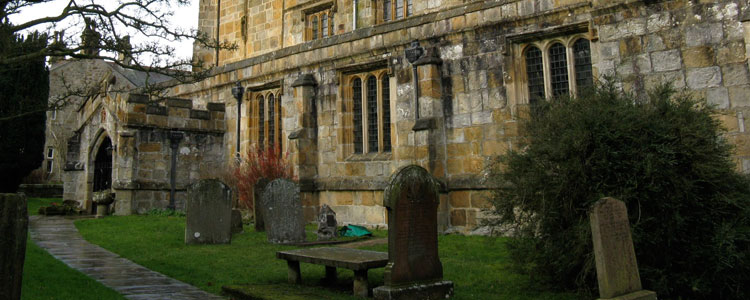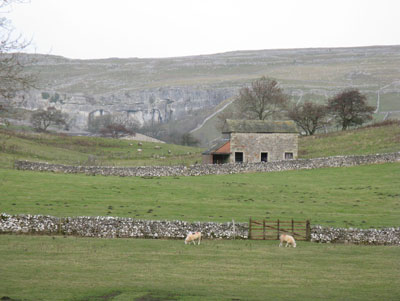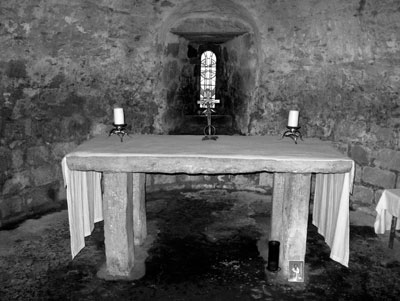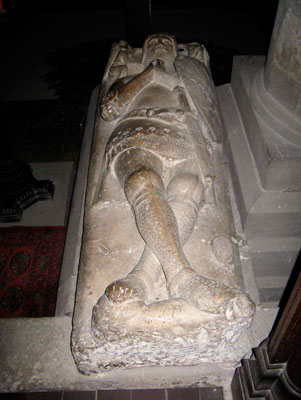Exploring North Yorkshire’s parish churches, keepers of history
by Marisue Pickering; Orono, ME
When visiting family in England, one of the things my husband, John, and I enjoy doing is exploring lesser-known, often out-of-the-way parish churches. All have features that make them special — if not to a large public then at least to the local population and the dedicated “church explorer.”
Church guides
Although we have been exploring British churches for several years, it was a mention in ITN (Oct. ’05, pg. 108) of Clive Fewins’ “The Church Explorer’s Handbook” that made us realize that what we had been doing had a name! We also discovered there were books available to help us.
Fewins’ book has been quite useful, as has another we found, Simon Jenkins’ “England’s Thousand Best Churches.” Jenkins comments on church art, calling churches a “dispersed gallery of vernacular art.” We agree. We have seen amazing local craftsmanship revealed in medieval stained glass, in eighth-century Anglo-Saxon sculptures and in contemporary decorations.
As family and friends have learned of our interest in England’s parish churches, they delight in taking us to yet another. In November ’08 we visited our family in Leeds, taking in three parish churches in North Yorkshire, all members of the Church of England.
St. Mary’s Church
As a result of earlier church visits, we had heard of St. Cedd, a seventh-century monk who had traveled throughout much of England founding monasteries and converting people to Christianity. When we realized that one of his monasteries had been in the village of Lastingham, just over an hour’s drive northeast from Leeds, we decided to visit the parish church built on the monastery site.
It was a bracing November morning with fog in the air when we drove to the attractive village of Lastingham through the spectacular barren beauty of the North Yorkshire Moors National Park. Once in the village, we asked the first person we saw where St. Mary’s church was and learned it was just around the corner from the main street.
Set on a small rise, the churchyard was quiet, evoking a feeling of remoteness. The church was unlocked (and nicely heated), and we were its only visitors.
Our primary interest in the church was its 11th-century shrine to St. Cedd, located in the crypt of the church and built over his presumed burial site. The crypt was easy to find.
Steps at the west end of the church took us down into a small, dark space of deep stillness and silence. There, at the east end, we saw a simple stone altar, located in front of a small ancient window containing 20th-century stained glass. Tradition suggests the altar is near where Cedd was buried. This would have been where medieval pilgrims came to pray and venerate the saint.
Four short, squat Norman columns support the crypt’s vault — a reminder that the crypt has not changed much since its construction. We realized we were actually in a miniature chapel, complete with side aisles, reading later that this type of chapel architecture is unique for a small English crypt.
The combination of the site’s long history as a place of devotion and the beauty of both the church and the drive through the Moors made our visit to St. Mary’s memorable.
Church of St. Peter and St. Paul
Of course we had to go to the historic market town of Pickering, even though we don’t know for sure that it is where my husband’s ancestors lived before emigrating to the US in the 1630s. It’s about an hour from Leeds and not far from Lastingham.
With its market, leisure center, cinema and tourism office, Pickering was bustling the Saturday afternoon we were there. Using a town map, we easily found the parish church. Situated on a small hill, it was near the center of town and was open.
The six of us — my husband and I, our son and his wife and our two preschool Pickering grandsons — had the church to ourselves.
Parish churches in England often date back many centuries and, as a result, reflect myriad restorations and renovations. Also, they often are built on sites of much earlier churches. Pickering’s Church of St. Peter and St. Paul is no exception; the first church on its site predated the Norman conquest of 1066.
Although the name “Pickering” was what drew us to the town, we soon learned that its parish church is known for its set of medieval wall paintings of religious stories, one of the most complete sets in Britain.
In the Middle Ages, church wall paintings were common and were used as an aid to worship. Paintings of religious themes helped illiterate congregations understand Biblical stories as well as theological concepts and church legends.
Painted in about 1460, the frescoes were covered over with a thick coat of plaster during the Reformation and only rediscovered in the mid-19th century. They then became a source of contention because the vicar felt they were a distraction from his sermons!
We were not able to get as good a look at the frescoes as we would have liked, primarily because the church was dimly lit — and dusk comes early in November in North Yorkshire. Even so, we could make out scenes of St. George slaying the dragon, the beheading of John the Baptist, and part of the legend of St. Catherine of Alexandria.
The paintings cover both the north and south walls of the church and are said to give an idea of what medieval church interiors were really like.
We had hoped that while in Pickering we would visit the 12th-century motte-and-bailey castle run by the English Heritage commission, but it is closed during the winter months. We did walk around the exterior of the castle, appreciating its beauty on an increasingly cold and foggy afternoon.
Church of St. Michael
We were on our way to Malhamdale in the Yorkshire Dales National Park, about an hour north and a bit west of Leeds, when we spotted a church tower in the rural community of Kirkby Malham and decided to take a look. What we found was a charming 15th-century parish church nestled in a churchyard on a side lane in a community too small even for the designation of “village.” The church, however, serves a large parish of 37 square miles.
Entering the church, we noticed a small, modern statue of St. Michael located in a niche above the entrance. We always find it interesting to see modern art in old churches — a reminder of the continual commitment to give voice to a current generation.
Inside the church, we were taken with the beauty of the old oak box pews. We could see slight differences in the pews, probably reflecting the individuality of the parishioners for whom they were originally built.
This was our first visit to the Yorkshire Dales, although we had known about the area from watching the James Herriot TV series, and I soon realized that the park shares at least one similarity with Acadia National Park, located in our home state of Maine: when visiting the park, you are continually driving through interesting small communities surrounded by stunning scenery.
Kirkby Malham is one such community in the Dales, and its interest is certainly enhanced by its parish church.
Our family’s flat in Leeds was too small to accommodate us, so we stayed nearby at the unpretentious Cresta Guest House (381 Street Lane; www.cresta.plus.com). A comfortable room with twin beds, a private bath and excellent full breakfast cost about $100 per night.
The owner, Elaine, went out of her way to welcome us and accommodate our vegetarian diet.
We traveled to the various churches with our family by private car.




